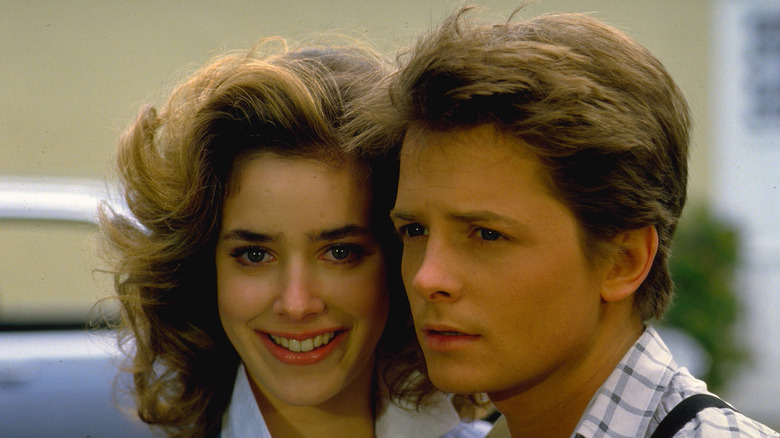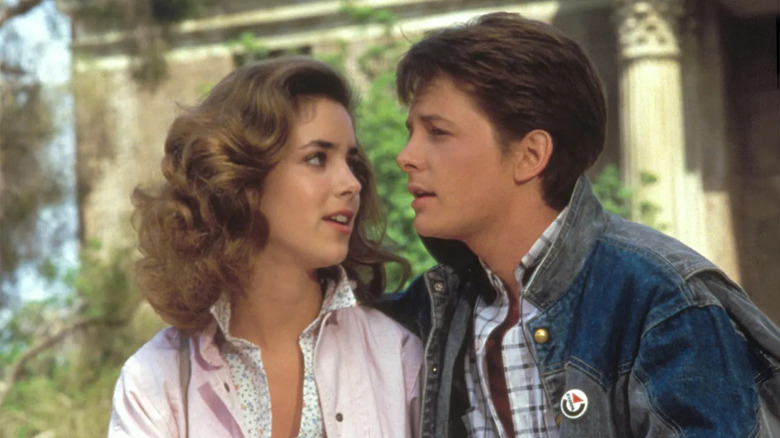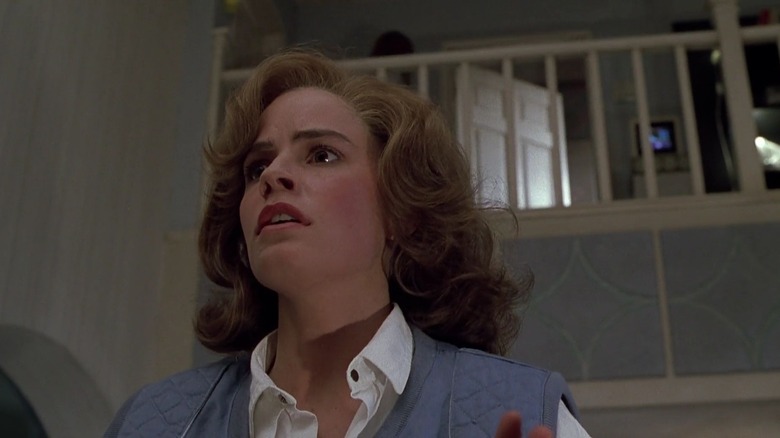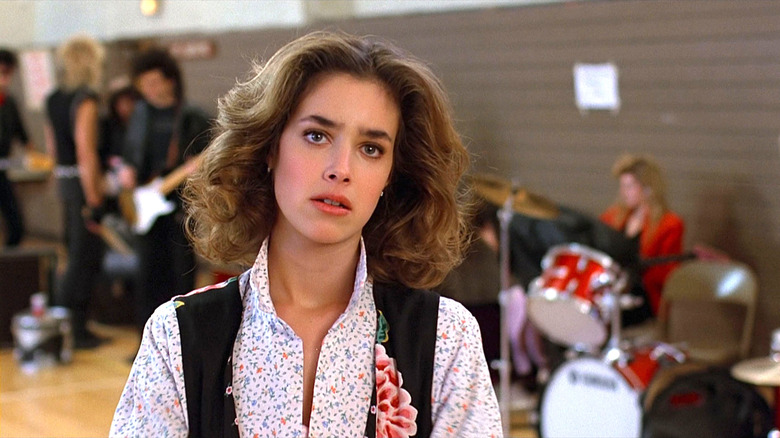Why The Back To The Future Sequels Featured A Different Jennifer
The ultimate joke of 1985's classic sci-fi adventure comedy, "Back to the Future," is that it was never intended to have a future beyond the first film. Director and co-writer Robert Zemeckis along with co-writer and producer Bob Gale have long maintained that the final moments of the film, which sees Marty McFly (Michael J. Fox), fresh from his trip to 1955, jumping into the time-traveling DeLorean with his pal Doc Brown (Christopher Lloyd) and girlfriend, Jennifer (Claudia Wells), to go take care of the couple's future children, was always intended as "a joke, a great payoff," according to Zemeckis.
Yet after "Back to the Future" found enormous success critically and commercially, Zemeckis and Gale were hounded by Universal Pictures to come up with a sequel. After a false start involving a story of Marty going back to the late '60s and almost preventing his conception, the filmmakers came up with an ingenious idea for using time travel to have the heroes literally go back into the first movie, and then added to that a third act involving their adventures in the Old West. When the first version of that script proved way too long for a single movie, Zemeckis and Gale convinced the studio to let them shoot two sequels back-to-back.
Given that there were no plans for a franchise originally, the actors all had to be coaxed back into the fold. Some refused to return, whereas others, like Claudia Wells, simply couldn't come back, resulting in a different Jennifer being cast for parts II and III.
The role of Jennifer Parker plays musical chairs
Ironically, the relationship between Wells and the role of Jennifer was already dramatic well before "Back to the Future Part II" came around. The actress was originally cast in the part for "Back to the Future" and even did some prep work with original Marty McFly actor Eric Stoltz. However, as the film was getting ready to go, Wells learned that a sitcom she had previously committed to was going into production, meaning the role had to be recast. Melora Hardin, an actor who would later go on to recur as Trudy Monk in "Monk" and Jan Levinson in "The Office," was then given the role. Wells was unusually content with these events, as she recalled to People Magazine in 2015:
"When I had to let it go, I had no qualms. And normally, if I didn't get a part that I wanted, I would have a lot of anxiety. But for some reason, I just felt a sense of peace. Like 'It's okay — everything's going to work out.'"
As Wells intuited, fate was not done with "Back to the Future" and its casting woes — infamously, Stoltz' portrayal of Marty McFly was not what Zemeckis and Gale had envisioned, and the filmmakers made the choice to let him go and recast with their original top choice for the part, Michael J. Fox. While Fox made a deal with producer Steven Spielberg and "Family Ties" creator Gary David Goldberg that would allow him to do double duty on the series and the movie, Zemeckis and Gale discovered the change in leading man necessitated a change in leading lady, given Hardin's stature at 5'7". Wells explained, "I'm 5'3 1/2,", and Michael's 5'4", so I got my part back! How cool is that? It's absolutely fate."
Fate intervenes
Sadly, Wells' good luck wasn't with her when it came time for "Back to the Future Part II." Thanks to Zemeckis and Gale dragging their feet when it came to making a sequel — both for reasons of originally not wanting to make it and then taking a while to crack the story for it, not to mention Zemeckis' technical difficulties making "Who Framed Roger Rabbit" in between — "Part II" wouldn't go before cameras until a full four years after the first film had been shot.
In that intervening time, Wells' mother, a manager, had been diagnosed with terminal breast cancer, and the actress simply couldn't consider returning to work at all during that period. As she elaborated:
"Life was very, very difficult and stressful. I just didn't have it in me to do anything but deal with the stress and the emotions that were going on as a result of my mom being in the process of dying. I just wasn't in a place to be able to think about my career or the film or anything other than what I was doing with my own life."
Thus, Jennifer Parker was recast for "Back to the Future Part II" and "Part III" with Elisabeth Shue. Wells was not only pleased, saying that she was "very flattered and honored because I think [Shue's] an amazing actress," but Shue's casting happened to be another ironic happenstance: according to Wells, the competition for the lead role in 1987's "Adventures in Babysitting" came down to between herself, Phoebe Cates, and Shue, with the latter landing the part.
Alternate pasts, presents and futures
After the dubious recasting of its lead actor, "Back to the Future" only got more complicated as a franchise from there. Not only did Wells have to drop out of Part II and III, but Crispin Glover (who played Marty's father George in the first film) refused to return for the sequels for entirely different reasons, leading to his role being recast with Jeffrey Weissman.
The sequel could've easily weathered one major recast actor, but two was another matter, not to mention the fact that the big idea for the third act of "Part II" was to insert new footage of Fox, Lloyd, and Thomas F. Wilson's Biff into repurposed footage from the first movie. Thus, Zemeckis and Gale decided to lean into the time travel shenanigans of their film and their franchise, going so far as to shoot most of Weissman's scenes from a distance, out of focus, or with the actor upside down. They also made a gag out of Fox playing nearly the entire McFly family tree, from Marty's son and daughter in 2015 to his great-great-grandfather in 1885. Wilson gets to give the Tannen family the same treatment, too.
In this way, the recasting of Jennifer seems more of a piece with the movie rather than sticking out like a sore thumb. After all, as the so-called "Butterfly Effect" postulates, who knows what Marty and Doc changed during their adventure through time that may have resulted in Jennifer, George, and several McFly's looking kinda different? If there's a major theme to the "Back to the Future" trilogy, it's that "Your future is whatever you make it."



